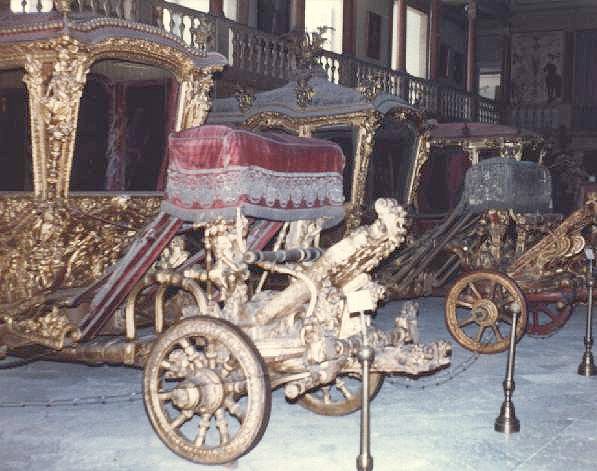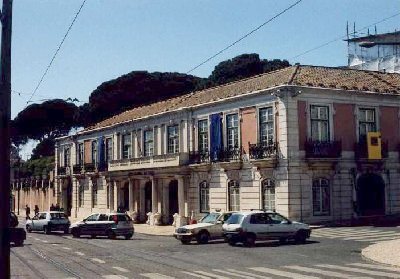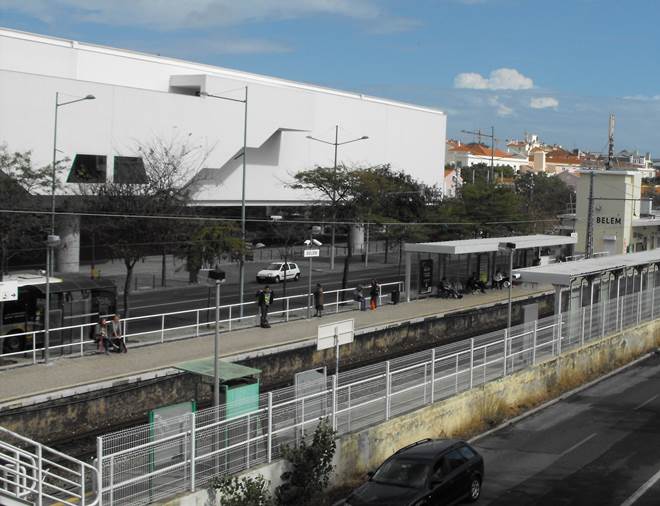The Coach Museum/ Museu dos Coches
 Lisbon's most-visited museum is its Museu dos Coches, which houses the best collection in the world of historic royal and other horse-drawn vehicles. The museum was the creation of Queen Amélia and opened in 1905 as the Museu dos Coches Reais (Museum of Royal Coaches), acquiring its new name after the 1910 Revolution had overthrown the monarchy. The heart of its collection comprises vehicles from the royal household and from the collection of the Patriarch of Lisbon.
Lisbon's most-visited museum is its Museu dos Coches, which houses the best collection in the world of historic royal and other horse-drawn vehicles. The museum was the creation of Queen Amélia and opened in 1905 as the Museu dos Coches Reais (Museum of Royal Coaches), acquiring its new name after the 1910 Revolution had overthrown the monarchy. The heart of its collection comprises vehicles from the royal household and from the collection of the Patriarch of Lisbon.
Historically the collection has been (and partly remains) housed in the former riding school of Belém Palace, built in 1726 by the Italian architect, Azzolini. It has a 1944 extension was by the celebrated architect, Raul Lino. The museum had a brief period at the Parque das Nações, the former Expo-98 site, near Oriente station, to allow roof repairs to be completed.
However, in 2015, much larger new purpose-built premises for the Museu dos Coches were opened more or less opposite the historic building but whose entrance and signage is not immediately visible from it. At the time of writing (2016) there is no physical link between the historic and the new building, although one is being built. In the meantime, it is far from obvious how to get from one to the other and neither of the premises makes particularly clear where the other building is or what each contains.
Left: An exhibit in the Museu dos Coches.
The new premises are now effectively the main building of the Museum and house the majority of the collection of historic carriages. The main entrance to the new main building is opposite Belem railway station which lies on the Cascais line. NB Not all trains from Lisbon stop at Belem; only those trains from Cais do Sodré which bear the destinations "Cascais TODAS" or "Oeiras TODAS" do so. Many trains which go to Cascais do NOT stop at Belem so the word TODAS is vital (TODAS means the train stops at ALL STATIONS).
The historic Coach Museum site is situated at the back of the park in the Praça Afonso de Albuquerque and is most easily reached by alighting at the Belém stop of the number 15 tram route from central Lisbon, or Algés. Buses serving the Belém site of the museum include Carris services 714, 727, 729, 751.
Getting between the two sites of the Museum is easy - once you know where you are going. To get from the new main building to the historic building, leave by the main exit (facing Belém station), turn right and then right again across the front of the museum cafe/restaurant called the Cavalo Lusitano. Walk to the next junction and the historic building is facing you, slightly to the left.
Both the hostoric and the main premises are well worth visiting though you can buy a ticket to either building or a combined ticket for both buildings (currently eight euros in 2016).
In the historic premises, the main display area is the architecturally atractive Salão Nobre (Noble Salon), an impressive room. The historic museum houses a much smaller number of coaches than the main building but it also has a second room which (2016) has an interesting collection of fire fighting carriages and equipment as well as items such as sedan chairs and smaller horse-drawn coaches.
The main building, a less attractive but spacious, hanagar-like room, has carriages dating back to Philip II's seventeenth century carriage.
The Museum has its own website.

Right: The Coach Museum's historic building
Major Exhibits
The major exhibits in the Museu dos Coches include:
King José's and King João V's coaches (18th century)
The coach in which the Marquês de Fontes went as ambassador to Rome in the eighteenth century.
Philip II of Spain (Filipe I of Portugal)'s coach - 16th century.
Pope Clement XI's coach.
Other Lisbon Museums
Other museums (most of which are closed on Mondays) which are well worth a visit include:
The Air Museum- Museu do Ar next door to Alverca railway station on the Azambuja railway line from Oriente and with another branch at Sintra (Granja) airbase.
The Ancient Art Museum : Museu Nacional de Arte Antiga - Lisbon's major art gallery. Near to
tram routes 15, 18 and to Alcântara-Terra railway station. Located in the Rua das Janelas Verdes.
Benfica Football Club Museum. Lisbon's most famous club has its museum at the famous Estádio da Luz in north west Lisbon.
The Carris Transport Museum at Santo
Amaro on tram route 15. Houses old trams and buses.
The Centro Cultural de Belém, includes the Berardo modern art collection.
The Ceramic Tile Museum: The Museu Nacional do Azulejo at Rua de Madre de Deus 4, on bus routes 18, 39A, 42, 104, 105. It is well worth the journey to this slightly out of town museum
The Communications Museum; Museu das Comunicações is at Rua do Instituto Industrial 16.
The Chiado Museum: Museu do Chiado, a fine museum of 19th- and 20th-century art, near Baixa-Chiado Metro station and tram route 28. Has an excellent small outdoor café
The Electricity Museum: Museu da Electricidade at Belém, near the
railway station, housed in a former power-generating station.
The Gulbenkian Museum: Museu Calouste Gulbenkian near
Palhavã and São Sebastião Metro stations. This has a world-famous collection of art and artefacts, including Egyptology and lalique-ware. Adjacent is the Museu da Arte Moderna.
The Lisbon City Museum: Museu de Lisboa in the Palácio
Pimenta at Campo Grande.
The Maritime Museum: Museu de Marinha at Belém. An excellent traditional musueum highlighting Portugal's many maritime achievements.
The Military Museum: Museu Militar, which stands opposite the main entrance to Sta Apolónia railway station. Both the interior of the building and its collections are impressive.
The Modern Art Centre: Centro de Arte Moderna at the Gulbenkian,
near Palhavã and São Sebastião
Metro stations.
The Museu de Arte, Arquitetura e Tecnologia is a striking modern building which was opened on 5 October 2016 adjacent to the Museu da Eletricidade, a former central electric generating station, near Belém railway station.
Museum of Design and Fashion: MUDE. Only opened in 2009/10 in the Rua Augusta.
Museum of the Oriente, Museu do Oriente. This is one of Lisbon's newest museums and is housed at Alcantara near the railway line and near tram route 15.
The Popular Art Museum: Museu de Arte Popular, opposite the Centro
Cultural de Belém, a folklore museum.
Sporting Lisbon Museum. The impressive Alvalade stadium, home of Lisbon's second most famous club, is near Campo Grande metro station.
Copyright: ©
Contact: the following is not a link; please transcribe the address into your email 


 14 October 2016
14 October 2016

 Lisbon's most-visited museum is its Museu dos Coches, which houses the best collection in the world of historic royal and other horse-drawn vehicles. The museum was the creation of Queen Amélia and opened in 1905 as the Museu dos Coches Reais (Museum of Royal Coaches), acquiring its new name after the 1910 Revolution had overthrown the monarchy. The heart of its collection comprises vehicles from the royal household and from the collection of the Patriarch of Lisbon.
Lisbon's most-visited museum is its Museu dos Coches, which houses the best collection in the world of historic royal and other horse-drawn vehicles. The museum was the creation of Queen Amélia and opened in 1905 as the Museu dos Coches Reais (Museum of Royal Coaches), acquiring its new name after the 1910 Revolution had overthrown the monarchy. The heart of its collection comprises vehicles from the royal household and from the collection of the Patriarch of Lisbon.

